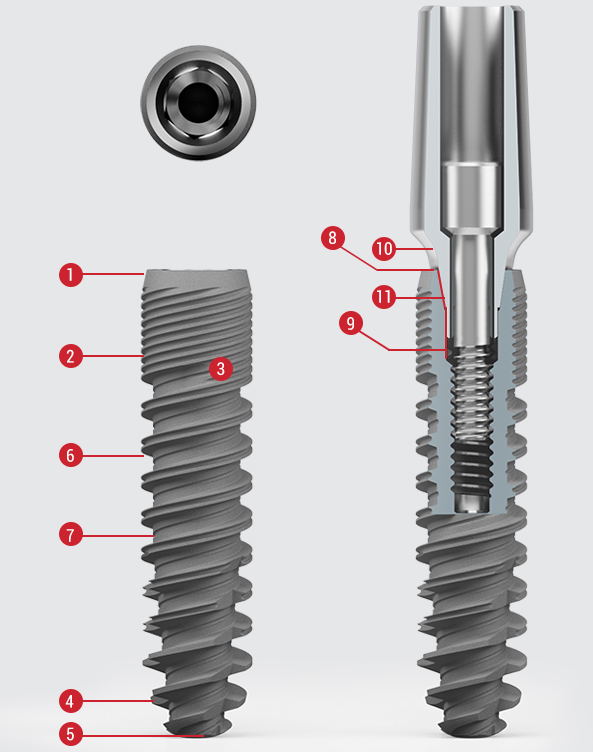ND / Narrow Diameter Implant


Download Catalogue
For more informations about ND Components please click here to download complete catalogue

10 year warranty
C-TECH offers a 10 year warranty on all implants and parts on implants and abutments. To request the warranty and find out more, click here.
ND / Narrow Diameter Implant
![]() The Narrow Diameter dental implant is a two piece slender bodied implant with a platform diameter of only 3mm. This implant is ideal for limited and narrow crestal spaces in the anterior region. Generous threading on the implant body, culminating in sharper threads at the apex deliver stability as well as ease of insertion.
The Narrow Diameter dental implant is a two piece slender bodied implant with a platform diameter of only 3mm. This implant is ideal for limited and narrow crestal spaces in the anterior region. Generous threading on the implant body, culminating in sharper threads at the apex deliver stability as well as ease of insertion.
- Read more »
A simplified surgical protocol in combination with the conservative dimensions of this dental implant facilitate the resolution of dental implant cases which would have otherwise required the use bone augmentation and higher treatment costs.
- 1Bevelled shoulder
– Facilitates bone growth above the shoulder.
– Long term implant stability.
– Biological repartition of the forces in cortical bone. - 2Micro grooving
– Softens forces to the cortical bone during insertion .
– Cortical bone maintenance. - 3
Passivated surfaceThe implant surface is blasted with aluminum oxide.
This surface treatment accelerates the osseointegration process by providing a greater and more uniform area of contact between bone and implant while favoring an immediate implant load.The treatment provides for a uniform surface with progressive trabeculation to be achieved.
- 4Aggressive apical design
– Ideal for immediate implant placement.
– Primary stability. - 5Rounded apex
– Protection of the sinus floor, nerve canal and other important anatomical structures during insertion.
- 6Double lead thread
– Insertion rate of 1,5mm per rotation.
– Primary stability
– Increased bone to implant contact
– Faster and even insertion while protecting bone structure - 7Thread in thread / groove in groove
– Increased bone to implant contact
- 8Platform switching
– Reduces bone loss
– Better representation of the biological width
– Long term esthetic stability - 9Indexing hex
– Antirotational security
- 10Concave esthetic concept
– Non surgical thickening of the peri-implantary tissue
– Facilitation of the papilla reconstruction-technique - 11Conical connection (cono-morse)
– Structural strength stability
– Reduction of micro-movement - Implant subcrestal seating
– Hinders exposure of the implant through bone resorption
– Ideal for the esthetic zone
– Long term esthetic stability - Three different threading profiles
– Thread designs adapted to different bone structures that occur along the depth of the implant
– Enhanced surface
– Round but cutting apex design
Dental Implants
| ø 3.1/9 mm | ND-3009 |
| ø 3.1/11 mm | ND-3011 |
| ø 3.1/13 mm | ND-3013 |
* All models are supplied with ND Narrow Diameter screw cap included
Purity and precision
Material purity and surface treatment
Material purity starts with the acquisition of raw material from only the most reliable sources of which each lot is accompanied by its own material certificate and is completely traceable at all phases of production and later use. The production facility in which all the implants and components are made is owned and operated by C-TECH and is certified to the highest standards governing the production of dental/medical devices. To maintain these standards, regular and independent audits are performed by TÜV Rheinland. All up to date certificates are available for download on the company website.
The machining of the EL implant is an intricate process due to the precision required for the Morse conical connection and the exterior complexity of the implant. This intricacy requires double the machining time that would be necessary for that of an average implant. Throughout and following each step of the production process, the implants are thoroughly cleaned in 5 seperate cleaning stages, consisting of a total of 20 cleaning cycles. This attention to cleanliness is in order to assure that no risk of any production residue is remaining on the implant surface.
The surface topography is created through a patented acid etching process. The adjacent photos made with a scanning electron microscope (SEM) demonstrate the lack of impurities on the implant surface as well the abundant surface area created through the patented acidification process.
The purity of the grade 4 titanium used for the EL implant and the surface topology were independently verified through an investigation carried out with a scanning electron microscope (SEM) by the University of Cologne and Medical Material Research Center of Berlin, Germany. The investigation demonstrated the highest level of purity and cleanliness resulting in the award of the BDIZ quality seal. This investigation is avaliable in its long form on the C-TECH website.
Precision components
The successful achievement of a Morse lock and cold weld seal in the implant-prosthetic connection depends on high precision machining. A perfect Morse connection will result in a structural integrity and strength that will be as if the 2 parts were fused together and thus will practically eliminate the gap between the implant and the abutment. Accordingly, the C-TECH components are machined to a tolerance of within 10 microns.
This mechanical fusion of the prosthetic part and the implant has 2 important benefits; prevention of the bacterial colonization of the gap, which can lead to bone loss around the implant, as well as the elimination of micro-movements between the implant and abutment and the consequent screw loosening which can lead to prosthetic failure. The SEM photos on the right show different magnifications of the tight abutment and implant connection. The final photo at the bottom, at 1000 X magnification, shows a fine line where the abutment and the implant meet. This practically nonexistent gap is less than the 1,5 microns width of the bacteria to be found in the oral cavity.












